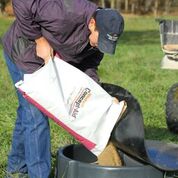 The main nutrient requirements for livestock are water, energy, protein, minerals and vitamins. In many cases, producers do a good job of providing enough water and adequate energy and protein sources. However, many producers fall short in providing the best nutritional program possible by purchasing “cheap” vitamin and mineral sources or failing to provide a vitamin and mineral source at all. Mineral nutrition for the cow is important year-round, but is particularly important during late gestation, calving and re-breeding. Management of the maternal unit throughout gestation and lactation not only impacts her productivity, but the performance and efficiency of her calf as well.
The main nutrient requirements for livestock are water, energy, protein, minerals and vitamins. In many cases, producers do a good job of providing enough water and adequate energy and protein sources. However, many producers fall short in providing the best nutritional program possible by purchasing “cheap” vitamin and mineral sources or failing to provide a vitamin and mineral source at all. Mineral nutrition for the cow is important year-round, but is particularly important during late gestation, calving and re-breeding. Management of the maternal unit throughout gestation and lactation not only impacts her productivity, but the performance and efficiency of her calf as well.
Why do animals need a good mineral program?
All animals have a defined set of nutritional needs. When nutrients run out, that is where performance stops. Minerals are an important component of these nutritional needs, and there is a delicate balance that is needed for maximum biological efficiency to be realized. Selecting the correct mineral supplement is essential for maintaining healthy animals, optimal growth and improved reproduction efficiency.
Nutritionally speaking, animals require two types of minerals: macro and trace minerals.
- Macro minerals – required in concentrations greater than 100 ppm
- Calcium, Phosphorus, Potassium, Magnesium, Sulfur, Sodium and Chlorine
- Trace minerals – required in concentrations less than 100 ppm
- Cobalt, Copper, Iodine, Manganese, Selenium, Iron and Zinc
How do I select the appropriate mineral program?
There are several factors to take into consideration when selecting a mineral program that is appropriate for your operation:
- Type of forages available and the season
- Grains and by-products fed
- Ca:P ratio
- Salt level
- Level of trace minerals
- Additives
- Bioavailability
- Performance goals of the operation
Are all minerals created equal?
Absolutely not. Minerals can come in organic and inorganic forms. Organic minerals are more bioavailable than inorganic minerals. This means that the more bioavailable a mineral is, the lower concentration that is needed to meet the animal’s requirements.
How much does a good mineral program cost?
A mineral program could cost anywhere from $20-40 per head annually, but feed additives included in some mineral mixes (i.e. Rumensin, Bovatec, Amaferm, etc.) can add $15-20, annually.
Let’s say a good mineral program costs $30 per bag ($1,200 per ton). For some, that may seem expensive and some producers may be tempted to buy the cheapest mineral possible. Mathematically, however, purchasing the cheaper mineral program doesn’t always pay in the long run.
- At a 4-ounce per day intake, the mineral only costs $.15 per day.
- $1,200 per ton ÷ 2,000 pounds = $.60 per pound
- $.60 per pound × .25 [4 ounces = .25 pounds] = $.15 per day
- The cost per year would be $54.75.
- $.15 per day × 365 = $54.75 per year
- Let’s say the cows nutritional needs are not being met because she is consuming a “cheap” mineral source, and doesn’t conceive on her first time coming back in to heat.
- Assume the price of a 600-pound feeder calf is worth $1.50 per pound
- If a calf weighs 80 pounds at birth, it needs to gain 2.5 pounds per day to reach 600 pounds at weaning (205 days of age)
- Remember that most operations wean all calves in one day
- If a calf is born just one cycle (21 days) later, a producer is losing 53.3 pounds of weaning weight
- 21 days × 2.5 pounds per day = 53.3 pounds
- At $1.50 per pound, that is $79.95 per head you can miss out on or $25.20 MORE than the cost of a “good” mineral program for the entire year.
- $1.50 per pound × 53.3 pounds = $79.95 LOST
The benefits of a good mineral program are research proven. There are numerous research articles available that support the case for providing cattle with a high quality, highly bioavailable mineral source. Some examples include:
- Fieser et al., 2006
- Documented an increase in performance of 0.27 lb. day over non-supplemented cattle.
- Horn et al., 2002
- Increased ADG of 0.16 (yr 1) and 0.26 (yr 2) lb. by steers given free-choice, non-medicated mineral compared to those with no supplement.
- Stanton et al., 2000
- Cows with high-level of inorganic trace minerals lost more weight than cows receiving organic trace minerals.
- Calves from cows on the high organic trace minerals saw higher ADG from birth to September.
- Pregnancy rate to AI was higher when cows were fed high levels of organic trace minerals.
What role does BioZyme’s proprietary prebiotic Amaferm® play in a good mineral program?
Amaferm is a natural feed additive used to improve the digestibility of feedstuffs and overall digestive health. Through increased feedstuff digestibility, more energy and microbial cell proteins are available to the animal for increased gain/body condition and feed efficiency to be achieved (Beck, 2012; Zerby et al., 2011; Caton et al., 1993). A healthy digestive system allows an animal to better utilize nutrients consumed, which translates into improved animal performance. Seventy percent of an animal’s immunity lies within its digestive system. Therefore, an animal with a healthy digestive system is more likely to perform to their genetic potential.